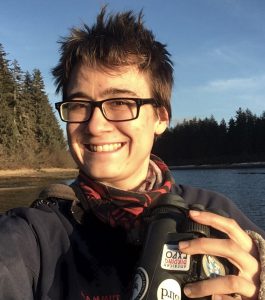 Christina Baal is an artist, illustrator, and environmental educator whose dream is to meet and paint 10,000 species of birds over her lifetime. After graduating from Bard College in 2014, she started her art business, “Drawing 10,000 Birds,” and has since traveled nonstop looking for birds. Christina loves going to bird festivals to show her work, lead trips, teach art, and spend time with the birding community. She has designed work artwork for the Space Coast Birding and Wildlife Festival, the Biggest Week in American Birding, the New River Birding and Nature Festival, New Jersey Audubon’s World Series of Birding, and created the Bird of the Year artwork for the American Birding Association in 2022. In between festivals, Christina works as an environmental educator and is a Master Naturalist for Wisconsin and California. Christina currently gets to live alongside her favorite bird, the California Condor, in Pinnacles National Park with her partner- a California Condor biologist- and their two golden retrievers.
Christina Baal is an artist, illustrator, and environmental educator whose dream is to meet and paint 10,000 species of birds over her lifetime. After graduating from Bard College in 2014, she started her art business, “Drawing 10,000 Birds,” and has since traveled nonstop looking for birds. Christina loves going to bird festivals to show her work, lead trips, teach art, and spend time with the birding community. She has designed work artwork for the Space Coast Birding and Wildlife Festival, the Biggest Week in American Birding, the New River Birding and Nature Festival, New Jersey Audubon’s World Series of Birding, and created the Bird of the Year artwork for the American Birding Association in 2022. In between festivals, Christina works as an environmental educator and is a Master Naturalist for Wisconsin and California. Christina currently gets to live alongside her favorite bird, the California Condor, in Pinnacles National Park with her partner- a California Condor biologist- and their two golden retrievers.

Christina Baal
Upcoming Events
This Nature Conservancy preserve is 2,303 acres of coastal prairie at the intersection of urban expanse and rural beauty. The coastal grasslands found here are vital to the natural resilience of the Gulf Coast—prairies and marshlands act as a natural buffer during storms and hurricanes, absorbing and dispersing water from storm surges and floods. The sponge-like qualities of the prairie are also important for filtering the freshwater that flows into the Gulf of Mexico—more than three million gallons enter the…
Find out more »Have you ever wanted to practice nature journaling, but found it difficult to know how to start? Or maybe you already love drawing, but want to learn some new tips and tricks to enhance your practice? This nature journaling workshop is designed to break through the trepidation of the “white page” and get you journaling right away.
Find out more »We will concentrate on gaining a deeper understanding of bird identification. Our approach is to observe differences in body structure, behavior, habitat preferences, and feeding styles of various species of birds. This trip allows us time to observe and discover the distinct characteristics of each species as opposed to generating a list of a larger number of species that we know little about. Notebooks are encouraged! We will proceed from the meeting site down Boddecker Rd through the East End…
Find out more »We love birds for so many reasons: their beautiful songs, their fascinating behaviors, their incredible life histories. And, of course, their gorgeous plumage! This outdoor watercolor workshop will focus on capturing the amazing colors and patterns of birds in an expressive, splashy watercolor painting style that is simple to use and requires basic, easy to obtain materials. The class will focus on letting go of anatomical perfection to examine instead a combination of emotion, energy, and color that portrays a…
Find out more »Join us for a trip to one of the largest migrant traps on the East end of Galveston Island. The Texas A&M Wetlands Center hosts mature oaks, hackberry, and mulberry trees as well as small freshwater and retention ponds. This attracts dozens of neo-tropic migrants including warblers, buntings, tanagers, and orioles.
Find out more »This trip takes you to a private property owned by the Galveston Bay Foundation (GBF) and not generally open to the public. GBF has conserved over 13,000 acres of critical coastal habitat in and around Galveston Bay. For decades, groundwater pumping in the region caused massive subsidence and contributed to the loss of wetlands. That coastal erosion meant wetlands around the bay sank into the water. Like many parts of Galveston Island, Sweetwater Preserve has sustained severe erosion. A 1,000-foot oyster reef project is part of larger restoration efforts in which the foundation has planted marsh along the shoreline. The reef protects the marsh from more degradation and protects the 464-acre property. This property includes a mixture of habitats including coastal prairie, estuarine marsh, salt flats, freshwater wetlands, brackish wetlands, and coastal woodlots.
Find out more »